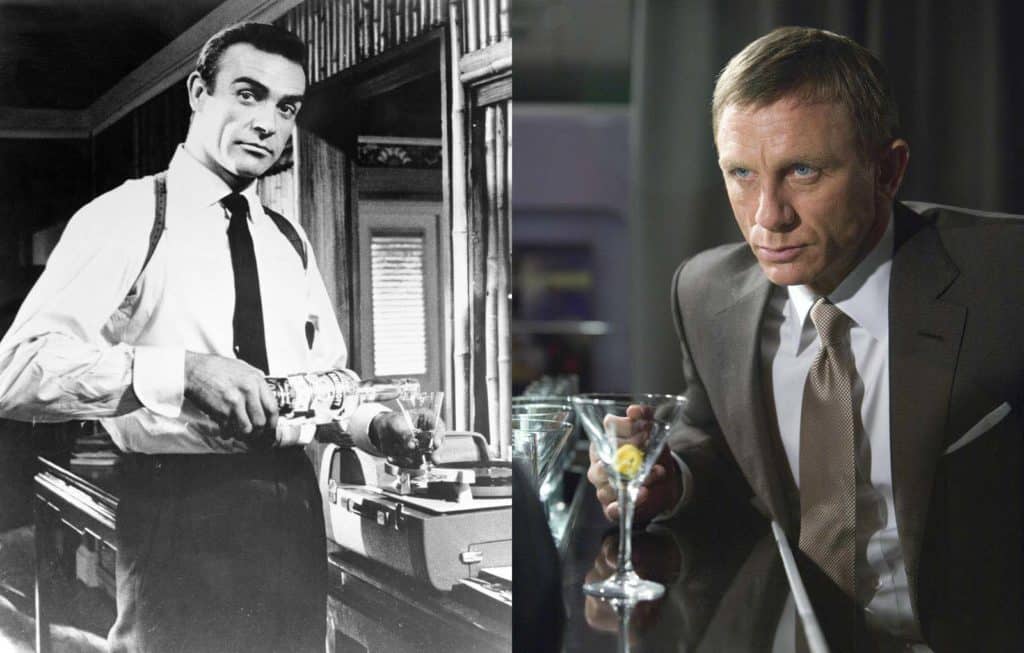
The movies will lie to you like a drunken lout in a bar at 3 a.m. who promises to pay you back after just one more drink.
In Sir Ian Fleming’s James Bond novels, the secret agent, who told everyone his name, only drank a martini once. That’s right, once. Through 26 movies, about 60 years and 12 actors, every single time Bond said “shaken, not stirred,” he strayed from the source material. The one time a martini was mentioned, it was in the book version of Casino Royale when Bond christened the drink made with half gin and half vodka after special agent—and his love interest—Vesper Lynd. Bond describes the Vesper Martini as follows: “Three measures of Gordon’s, one of vodka, half a measure of Kina Lillet. Shake it very well until it’s ice-cold, then add a large thin slice of lemon-peel.” But then Lynd commits suicide, and Bond never touches a martini ever again. He would drink bourbon, champagne and nearly every other spirit—but not martini.
But, it’s fine. Let’s operate under the assumption that the world’s most famous international man of mystery constantly drank martinis whilst preying upon innuendo-named women across the globe and continue this spy-themed article on the origins of the martini.

Drunk History
There are more than a few bartenders and master mixologist throughout time that claim credit for inventing the martini. The most famous one comes from the Knickerbocker Hotel in New York City, where bartender Martini di Arma di Taggia is purported to have poured the first martini prior to World War I. The feisty Italian’s recipe for the drink contained dry gin and dry vermouth, in equal parts, with orange bitters. But years before that, the drink is said to have been invented in Britain and named after the Martini & Henry rifles used by the British army because of the strong kick possessed by both the drink and the rifle.
But the earliest mention of the martini by names comes from the San Francisco gold rush era at the Occidental Hotel when a bartender named Jerry Thomas concocted the cocktail for a miner that wanted to spend his gold nuggets on a special beverage. And since the miner was headed for Martinez, CA, Thomas—the Lebron James of gold rush-era mixology—named the drink a martinez (close enough). The recipe for that drink lists a dash of bitters, two dashes of maraschino (cherry liquor), a full glass of sweet vermouth, a pony of Old Tom gin and a quarter slice of lemon—not quite a martini, but good enough for a dirty old prospector.
Regardless of the actual origin, the drink gained a thirsty following. It even showed up in noted heavy drinker Ernest Hemingway’s 1929 book, A Farewell to Arms, with the proclamation, “I’ve never tasted anything so cool and clean…They make me feel civilized.”
From that early product placement and on to Bond’s first (and yes, only) utterance, the popularity of the martini never dried up. In fact, during the 1950s and ’60s, the “three martini lunch” became a fashionable way for day-drinking executives and businessmen to avoid doing any real work.

Booze, Olives & One Troublesome Glass
Fancy variations aside, a traditional martini includes gin and dry vermouth served frigidly cold with a green olive or lemon garnish. And while the earliest versions of the drink boasted a gin to vermouth ratio of 1:1, the amount of gin has increased as the years have passed. As for the distinction between a dry and a dirty martini, the dry martini has less vermouth, while a dirty one gets kinky with multiple dashes of olive brine.
And as for the most appropriate times to drink a martini, for me, it’s always at a wedding. I like to order my martinis “extra dirty” with at least three olives. Perhaps what I really want at these functions is a bowl of olives, but it’s important to convey a sense of class at weddings. The one martini factor I cannot seem to come to grips with is that confounded martini glass. Just try to make it from the bar back to your table without spilling a drop of drink from that ridiculously designed vessel. You’re better off downing the martini at the bar, then asking the bartender to fill your empty glass with as many olives as possible.
Martini Variations
No other adult beverage has had so many people take so many liberties with its name. Sassy bartenders across the world have taken to lopping off the “mar” in favor of dozens of prefixes placed in front of the “tini.” There’s the appletini, bikinitini, saketaini, rumtini, cosmotini, something called the “Pepe’s Flaming Love-tini, and a painful number more.
I’m not here to tell you what you should and shouldn’t drink, but I for one have no interest in anyone’s love-ini, especially Pepe’s Flaming version. If you want a martini variation, keep it simple. When vodka replaces the gin, that is what’s known as a “kangaroo,” and when the olive is replaced by a cocktail onion, it’s called a “Gibson.”
And no matter what you do and no matter what Bond says, martinis almost always stirred, not shaken. So class it up, keep it simple, and get dirty with a martini. It might not be Bond’s favorite drink, but he’s a fictional character and you’re a real person, so who cares.
The Classic Martini
Over the years, the martini has become the most classic of cocktails. Try this recipe for the libation in it’s simplest and purest form.
3 oz. gin or vodka
½ oz. dry vermouth
Pimiento-stuffed olives
Ice cubes
1. Fill a shaker three-fourths of the way full with ice.
2. Add gin and vermouth; cover and shake until condensation forms on outside of shaker.
3. Strain into a chilled cocktail glass and garnish with olives.
For en extra dry martini, use less vermouth and for a wet martini, use more.



































